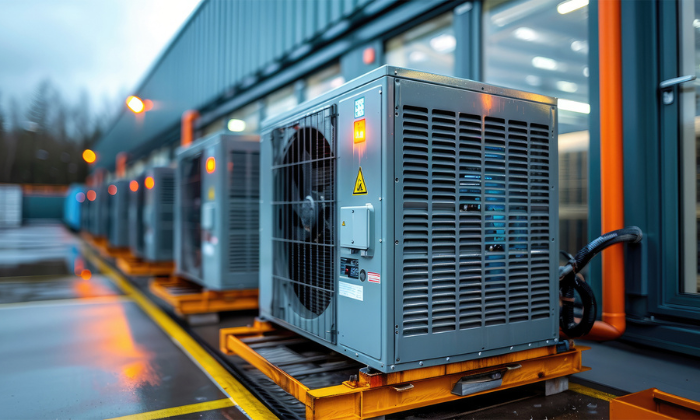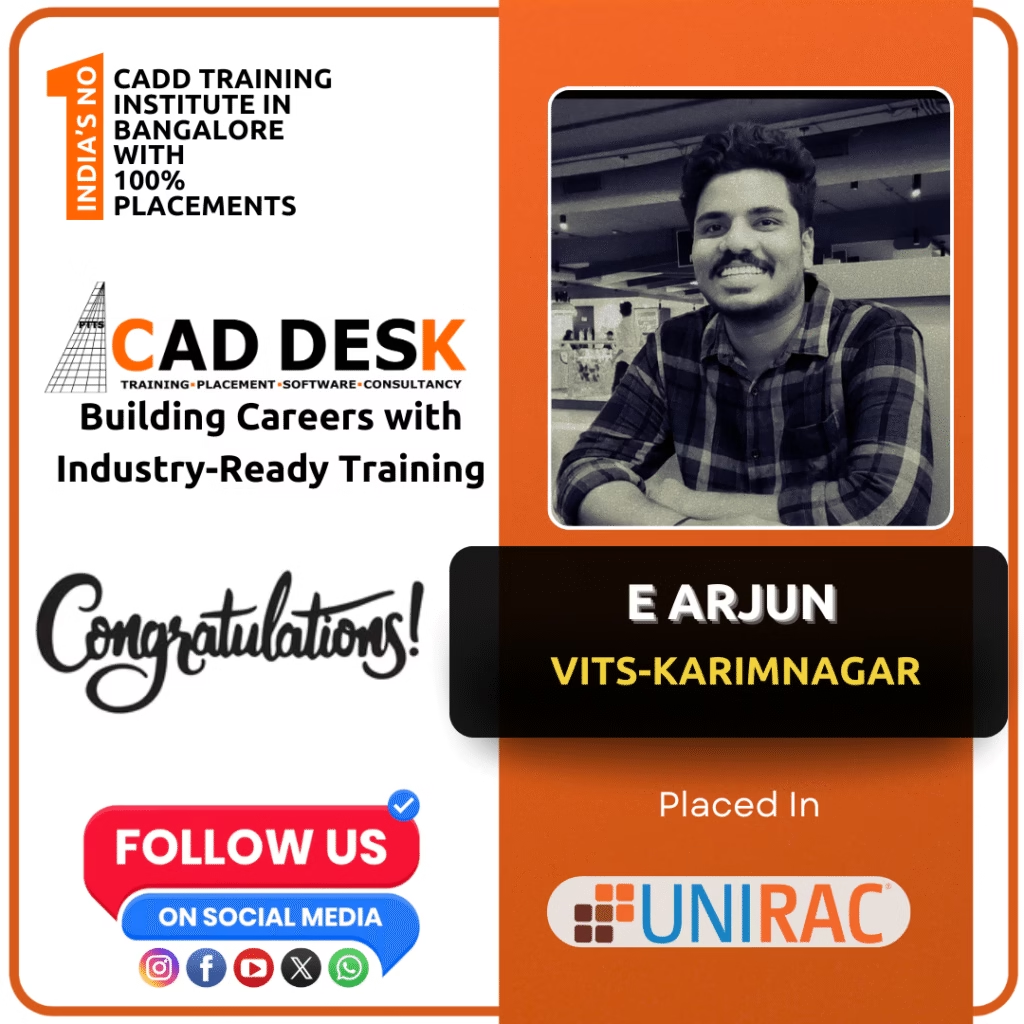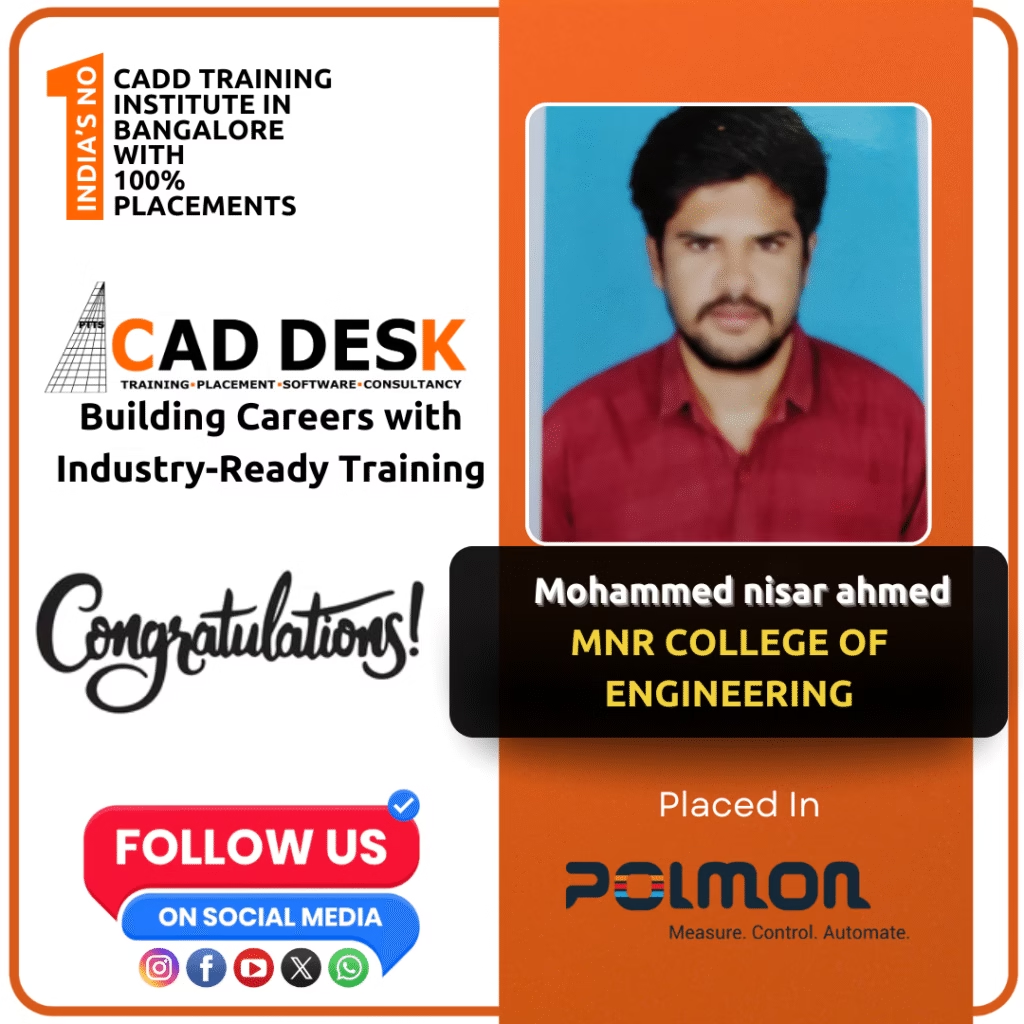
Our Placed Students


















































About Hvac Course
The HVAC Course at Caddesk Bangalore is designed to provide in-depth knowledge and practical skills in the field of Heating, Ventilation, and Air Conditioning (HVAC). HVAC systems play a critical role in maintaining comfortable indoor environments in residential, commercial, and industrial buildings. The HVAC course is ideal for students, engineers, and professionals who wish to advance their skills in designing, installing, and maintaining HVAC systems using modern tools and software. This course covers a wide range of topics, from the basic principles of HVAC systems to more advanced concepts like load calculations, duct design, energy efficiency, and system optimization. Participants will learn how to design HVAC systems that are energy-efficient, cost-effective, and compliant with industry standards and regulations. The curriculum is designed to equip students with the necessary knowledge to apply HVAC design principles in real-world situations, making them capable of handling projects involving air conditioning, heating systems, and ventilation systems. Throughout the HVAC course, students will gain hands-on experience using industry-standard software like AutoCAD and Revit, which are essential for designing HVAC systems. The course also emphasizes the importance of understanding building codes, energy regulations, and sustainability in the context of HVAC design, ensuring that students can contribute to projects that meet modern environmental standards. The HVAC course at Caddesk Bangalore is taught by experienced instructors with extensive industry experience, who provide practical insights and real-world applications of HVAC design and system management. The course is structured to offer both theoretical learning and hands-on training to ensure that students can confidently apply their knowledge in the workplace. The training includes a combination of classroom sessions, interactive learning, and project-based work, giving students the skills needed to excel in the field of HVAC. Upon completing the HVAC course, students will be well-prepared to take on roles as HVAC design engineers, system operators, and maintenance experts. They will have the expertise to design, install, and maintain HVAC systems that ensure optimal performance and energy efficiency. With ISO certification and the option for both offline and online training, Caddesk Bangalore provides flexible learning options to cater to a wide range of students, helping them achieve success in the HVAC industry. Best HVAC Course in Bangalore.
Hvac Course Overview
The HVAC Course at Caddesk Bangalore is an intensive training program designed to equip individuals with the skills and knowledge required to excel in the Heating, Ventilation, and Air Conditioning (HVAC) industry. The course covers the fundamental principles of HVAC systems, including the design, installation, operation, and maintenance of heating, ventilation, and air conditioning systems. It is suitable for engineers, designers, and professionals who wish to enhance their expertise in this field. The curriculum of the HVAC course is structured to provide both theoretical and practical knowledge. Participants will learn the essential concepts such as HVAC system components, system efficiency, heat load calculations, airflow distribution, and energy efficiency standards. The course also dives into advanced topics, including the integration of smart systems, sustainable design strategies, and the impact of modern technologies on HVAC system performance. Students will receive comprehensive training on industry-standard tools and software like AutoCAD, Revit, and HVAC design software, which are essential for creating accurate HVAC designs and ensuring that installations are done according to industry standards. The course also teaches students how to perform duct design, system balancing, and how to troubleshoot and maintain HVAC systems effectively. Hands-on experience is a key aspect of the HVAC course. Students will work on live projects, gaining practical exposure to real-world HVAC challenges. They will also learn how to evaluate system performance, conduct energy audits, and optimize the efficiency of HVAC systems for various types of buildings, from residential to industrial. By the end of the HVAC course, students will be proficient in designing and implementing HVAC systems that meet energy efficiency goals, comply with building codes, and contribute to sustainable building practices. They will also be well-prepared to work as HVAC engineers, design specialists, and system managers in a variety of sectors, including construction, building services, and facilities management. The course at Caddesk Bangalore is available in both offline and online formats, allowing flexibility for students to learn at their own pace. Whether you are looking to start a career in HVAC or upgrade your existing skills, the HVAC course at Caddesk Bangalore provides a comprehensive learning experience that helps you succeed in the competitive HVAC industry. Best Hvac course in Bangalore.
Hvac Course Curriculum
- Overview of HVAC: Definition, history, and importance
- Basic components of HVAC systems
- Types of HVAC systems: Residential, commercial, and industrial
- HVAC system operation and safety protocols
- Fundamentals of heating: Heat transfer, energy types Types of heating systems: Furnaces, boilers, and heat pumps Installation and maintenance of heating systems Energy efficiency in heating Troubleshooting heating system issues
- Understanding air movement and ventilation requirements
- Types of ventilation systems: Natural, mechanical, and hybrid
- Air distribution and ductwork design
- Indoor air quality and ventilation standards
- Testing, adjusting, and balancing ventilation systems
- Basic refrigeration cycle and principles
- Types of air conditioning systems: Window units, split systems, central AC, etc.
- Installation and service of air conditioning units
- Energy efficiency and refrigerants (R-22, R-410A)
- Troubleshooting cooling systems
- Introduction to refrigeration: Principles and applications
- Types of refrigeration systems: Domestic, commercial, and industrial
- Refrigerants and environmental considerations
- Installation, operation, and maintenance of refrigeration systems
- Diagnosing and repairing common refrigeration issues
- Basics of electrical circuits and components
- Reading and interpreting HVAC wiring diagrams
- Electrical motors and controls in HVAC systems
- Troubleshooting electrical components
- Safety practices in handling electrical systems
- HVAC load calculations (Heating and cooling)
- HVAC equipment selection and sizing
- Airflow and ductwork design principles
- HVAC design software tools (AutoCAD, Revit MEP)
- Energy-efficient design principles
- Principles of thermodynamics relevant to HVAC
- Fluid dynamics in air conditioning and heating systems
- Calculations related to pressure, flow, and temperature
- Application of fluid mechanics in HVAC system design
Our Hiring Clients






















Career Opportunities
- HVAC Technician
- HVAC Engineer
- Building Services Engineer
- HVAC Design Engineer
- HVAC Sales Engineer
- HVAC Controls Technician
Online Hvac Course
The Online HVAC Course at Caddesk Bangalore is designed for individuals who wish to gain in-depth knowledge and practical skills in Heating, Ventilation, and Air Conditioning (HVAC) from the comfort of their homes or offices. This online course offers the flexibility to learn at your own pace while providing access to high-quality content, expert instructors, and interactive learning tools. The online HVAC course covers the entire spectrum of HVAC systems, including their design, installation, operation, and maintenance. Students will be introduced to the basic principles of HVAC design, such as heat load calculations, airflow distribution, and system efficiency. The course also delves into advanced topics, such as energy-efficient HVAC systems, smart building technologies, and sustainability in HVAC design. The course is structured to provide both theoretical understanding and practical application, making use of industry-standard tools and software like AutoCAD, Revit, and specialized HVAC design software. These tools help students learn how to design accurate and efficient HVAC systems for various types of buildings, ensuring they are capable of meeting energy efficiency standards and complying with local building codes. Students will also work on real-world projects, enabling them to apply their learning to actual HVAC challenges. The course covers critical aspects of HVAC systems, such as duct design, system balancing, troubleshooting, and system optimization. This hands-on training ensures that students develop the skills necessary to excel in the HVAC industry. One of the key benefits of the online HVAC course is the flexibility it offers. Students can access recorded lectures, interactive tutorials, and live sessions at their convenience, allowing them to learn at their own pace and revisit material as needed. The course is designed to cater to both beginners and experienced professionals, providing all the resources needed to enhance HVAC knowledge. Upon successful completion of the online HVAC course, students will receive certification from Caddesk Bangalore, a trusted name in engineering and design training. This certification enhances career prospects by demonstrating proficiency in HVAC design and system optimization. Whether you’re looking to start a career in HVAC or upgrade your skills, the online HVAC course at Caddesk Bangalore offers an accessible and flexible learning experience for aspiring HVAC professionals. Best Hvac course in Bangalore.
Why Caddesk Bangalore Is Best Hvac Course:
Caddesk Bangalore is the best HVAC course due to its industry-focused approach, expert trainers, and comprehensive curriculum. The HVAC course at Caddesk Bangalore is designed to provide both foundational knowledge and hands-on experience in Heating, Ventilation, and Air Conditioning systems. Whether you are a beginner or a professional looking to advance your skills, this course offers everything you need to excel in the HVAC industry. One of the key reasons why Caddesk Bangalore stands out is the use of industry experts as instructors. The trainers at Caddesk Bangalore are highly experienced professionals who bring years of practical knowledge to the classroom. They ensure that students gain not just theoretical knowledge, but also practical insights into real-world HVAC challenges. This helps students understand the latest industry trends, technologies, and practices that are essential in today’s competitive job market. The HVAC course at Caddesk Bangalore includes comprehensive training on all aspects of HVAC systems, including system design, load calculations, airflow distribution, energy efficiency, and sustainable HVAC design. The course is structured to provide a balanced mix of theoretical knowledge and practical application, using state-of-the-art tools and software such as AutoCAD, Revit, and other HVAC design tools. Students learn to design and optimize HVAC systems that meet energy efficiency goals, comply with building codes, and ensure long-term performance. Caddesk Bangalore offers flexible learning options with offline and online training. This flexibility makes it easier for students to learn at their own pace, whether they prefer to attend classes in person or learn remotely. The online HVAC course is structured to offer the same high-quality education with live interactive sessions, recorded lectures, and hands-on projects that can be completed at the student’s convenience. Another advantage of the HVAC course at Caddesk Bangalore is the ISO certification that students receive upon course completion. This certification is a testament to the student’s competence in HVAC design and is recognized by leading organizations and employers in the industry. The certification adds credibility to the skills learned, enhancing job opportunities and career growth. The course also emphasizes practical training through real-world projects, case studies, and simulations, ensuring that students gain experience that directly translates to workplace challenges. From duct design to system troubleshooting and optimization, students will learn to handle a variety of tasks that are part of everyday HVAC projects. If you’re looking for the best HVAC course in Bangalore, Caddesk Bangalore offers a top-tier learning experience that combines expert guidance, industry-standard software training, hands-on practice, and flexible learning options. Whether you’re looking to launch a career in HVAC or expand your skill set, Caddesk Bangalore provides the tools, resources, and support you need to succeed in the HVAC industry. Best Hvac course in Bangalore.
Hvac Course Highlights
- Expert Trainers
- ISO Certification
- Industry Course Content
- Reference Guides
- Practice Materials
- Career Guidance
- Student login
- 100% Interviews
- Placement Training
What Our Student Says
One of the best Institute for cadd training in banglore with friendly staff and good assistance is provided by manohar sir in placements
FREQUENTLY ASKED QUESTION
The main purposes of a Heating, Ventilation and Air-Conditioning (HVAC) system are to help maintain good indoor air quality (IAQ) through adequate ventilation with filtration and provide thermal comfort. HVAC systems are among the largest energy consumers in schools.
The most common type of HVAC is a heating/cooling split system. The air conditioner is the outside unit. The furnace is the inside unit. Both distribute air into the same ductwork.
CFM HVAC is an airflow calculation made in cubic-feet-per-minute (CFM). It’s used to determine the cooling requirements of a building and, in turn, its HVAC requirements in tons. A 1,200 CFM requirement would typically need a 3-ton HVAC system.
The ideal HVAC system for your home may be electric, propane air conditioning, or a natural gas unit, depending on personalized factors like upfront costs, efficiency, safety, and potential energy supply disruptions.
The goal of HVAC is to provide thermal comfort and acceptable air quality within that environment. HVAC system design is considered a part of mechanical engineering and uses the principles of thermodynamics, fluid mechanics and heat transfer to achieve it’s primary aim.

